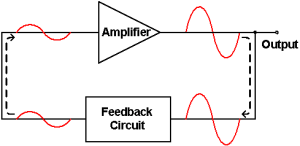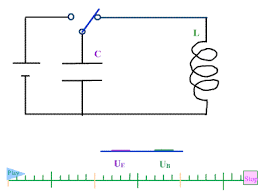An oscillator is an electronic device which provides the source of a repetitive alternating current signal across its output terminal without needing any input because signal generated is usually of constant amplitude. Common signals generated includes clock signals, sound signals produced by video games, electronic beepers and broadcast signals by television and radio transmitters. In our previous article, we explain about oscillator circuit in brief. Have a look at it.
Generally, oscillators are characterized according to the frequency generated at their output signal because for stabilization different frequencies are required in different areas. For example:
- For producing signals in the radio frequency range of about 100 kHz to 100 GHz, RF oscillators are used.
- For producing signals in the audio range of about 16Hz to 20 kHz, audio oscillators are used.
Oscillator Types
An oscillator is a mechanical or electronic device that works on the principle of oscillation i.e. a periodic fluctuation between two things based on changes in energy. It employs a sensitive amplifier whose output is fed back to the input in phase, this type of feedback is known as positive feedback. The wave shape and amplitude are determined by the design of the oscillator circuit and choice of component values. Two main types of oscillators are Harmonic or linear Oscillator and Relaxation or Non-linear oscillator.
A harmonic oscillator or Linear Oscillator
These oscillators generally produce sinusoidal output such as sine and cosine wave. They ideally produce wave output of constant amplitude and stable frequency. Depending upon the following factors these are of two types:
(A) Feedback oscillators:
[Image source]
These types of oscillators basically return a fraction of the output signal to the input with no net phase shift, resulting in an augmentation of the output signal. For gain (either an op-amp or discrete transistor) and a positive feedback circuit, it consists of an amplifier that produces phase shift and provides attenuation. It can be classified according to the type of frequency selective filter they use in the feedback loop. Following of Feedback oscillators are:
(i) LC oscillator:
In LC oscillator circuit, the inductor and capacitor are connected in parallel form a Tank circuit. Through the inductor charge flows back and forth between the capacitor plates, so the tuned circuit can store electrical energy oscillating at its resonant frequency. Inside the tank circuit, small losses occur but the amplifier compensates for those losses and supplies the power for the output signal. This type of oscillator is commonly used in radio frequency circuits because of their ease of implementation and good phase noise characteristics. When a tunable frequency source is necessary, then LC oscillators are used at radio frequencies in tunable radio transmitters, radio receivers, signal generators etc. Following types of LC oscillators are Hartley oscillator, Colpitt’s oscillator, Clapp oscillator.
(ii) RC Oscillator:
In RC oscillator circuit, the resistor and capacitor are connected as a filter network. These types of oscillators are mostly used to generate lower frequencies for example in the audio range. To produce resonating circuit at low frequencies the value of L and C will be taken too large which is not practically prefer, that’s why RC filter type combinations are preferred to generate sine waves at these frequencies. Following types of RC oscillator circuits are the Wien bridge oscillator and phase shift oscillator.
(iii) Crystal Oscillator:
 This oscillator is the most basic type of linear oscillator used to generate the clock signals in quartz clocks & computers and to stabilize the frequency of radio transmitters. At radio frequency, a quartz crystal component is used to determine the frequency of oscillation when subjected to an alternating voltage vibrates at a very precise frequency. The frequency depends on the physical dimension of the crystal, therefore, once the crystal has been manufactured to specific dimensions, the frequency of oscillation is extremely accurate. Quartz crystals are limited to frequencies of 30 MHz or below. Crystal oscillators have much better frequency stability than LC or RC oscillators because they have a high Q factor and better temperature stability than tuned circuits.
This oscillator is the most basic type of linear oscillator used to generate the clock signals in quartz clocks & computers and to stabilize the frequency of radio transmitters. At radio frequency, a quartz crystal component is used to determine the frequency of oscillation when subjected to an alternating voltage vibrates at a very precise frequency. The frequency depends on the physical dimension of the crystal, therefore, once the crystal has been manufactured to specific dimensions, the frequency of oscillation is extremely accurate. Quartz crystals are limited to frequencies of 30 MHz or below. Crystal oscillators have much better frequency stability than LC or RC oscillators because they have a high Q factor and better temperature stability than tuned circuits.
(B) Negative resistance oscillator:
At high frequencies in the microwave range and above these types of oscillators are used into which a resonant circuit is connected across a device with negative differential resistance. The negative resistance of the active device cancels the internal loss resistance in the resonator and generates continuous oscillations at its resonant frequency. Some linear oscillators can also be built using one port devices with negative resistance such as Gunn diodes, magnetron, lambda diodes, tunnel diodes etc.
Relaxation oscillator or non-linear oscillator:
These oscillators produce a non-sinusoidal output such as square wave, triangular or sawtooth wave. In a feedback loop, it consists of energy storing element i.e. capacitor, inductor etc and a non-linear switching device i.e. latch, Schmitt triggers etc. To produce a timing delay between two actions relaxation oscillators use two amplifiers and a frequency control network. The two amplifiers operate in switch mode either fully On or fully Off and at the time, the transistor in the switching mode it lasts for a small fraction of each cycle of the wave. To provide the clock signal for the sequential logic circuits such as timers and counters square wave relaxation oscillators are used. To generate square and triangle waves for testing equipment these are also used in voltage controlled oscillators, dual slope analog to digital converters, switching power supplies and in function generators.
Hope you all like this article. For any suggestion please comment below. We always appreciate your suggestions.







3 Comments